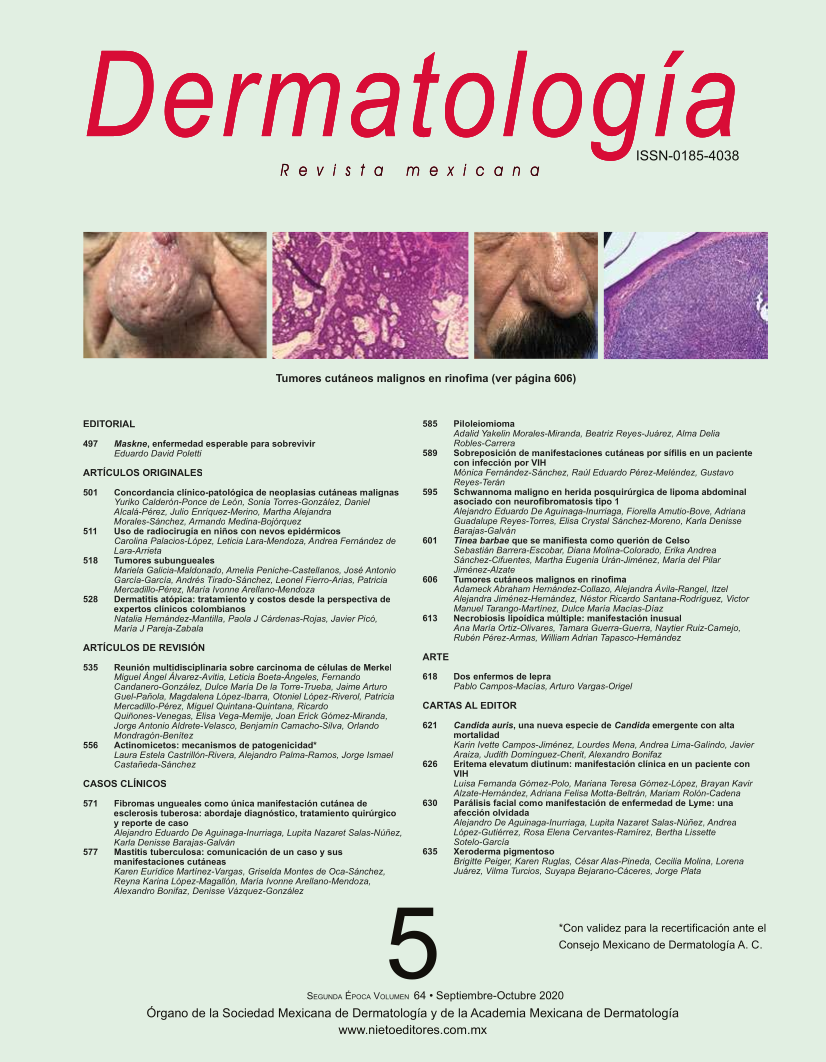Nail fibromas as unique cutaneous manifestation of tuberous sclerosis: diagnostic approach, surgical treatment and case report.
Dermatol Rev Mex. 2020; 64 (5): 571-576.
Alejandro Eduardo De Aguinaga-Inurriaga,1 Lupita Nazaret Salas-Núñez,2 Karla Denisse Barajas-Galván2
1 Servicio de Dermatología.
2 Servicio de Patología.
Hospital Civil de Guadalajara Fray Antonio Alcalde, Guadalajara, Jalisco, México.
Resumen
ANTECEDENTES: Los tumores de Köenen son manifestaciones cutáneas de esclerosis tuberosa, una genodermatosis con afección sistémica. El conocimiento de estos tumores es importante para el diagnóstico y tratamiento tempranos de esta enfermedad, que puede ser difícil de plantear o diagnosticar cuando no se cuenta con la tríada clínica característica.
CASO CLÍNICO: Paciente femenina de 42 años quien refirió la aparición de pequeños tumores circundantes a la uña a los 16 años de edad que fueron creciendo progresivamente hasta ser incómodos. A la exploración física se encontró una dermatosis múltiple en varios dedos de las manos y los pies, constituida por neoformaciones lisas, color piel, de aproximadamente 5 mm con poca hiperqueratosis en su punta, de consistencia blanda y en algunas con distrofia canaliforme de la lámina ungueal.
CONCLUSIONES: La existencia de múltiples fibromas ungueales es clave para realizar el abordaje correspondiente en búsqueda de esclerosis tuberosa, porque éstos pueden ser la primera y única manifestación cutánea de esta enfermedad.
PALABRAS CLAVE: Tumor; fibromas; esclerosis tuberosa; enfermedad de Pringle-Bourneville.
Abstract
BACKGROUND: Köenen tumors are cutaneous manifestations of tuberous sclerosis, a genodermatosis with systemic involvement. The knowledge of these tumors is important for the correct and early treatment of this entity, that may be difficult to diagnose when the characteristic triad is not available.
CLINICAL CASE: A 42-year-old female patient who reported the appearance of small tumors surrounding the nail at 16 years of age, which progressively grew until they were uncomfortable. Upon physical examination, multiple dermatoses were found in several fingers and toes, consisting of smooth, skin-colored neoformations, approximately 5 mm with little hyperkeratosis at the tip, white in consistency and in some with canaliform distribution of the nail plate.
CONCLUSIONS: The existence of multiple nail fibroids is key to perform the corresponding approach in search of tuberous sclerosis, because they may be the first and only cutaneous manifestation of this disease.
KEYWORDS: Tumor; Fibromas; Tuberous sclerosis; Pringle-Bourneville disease.

